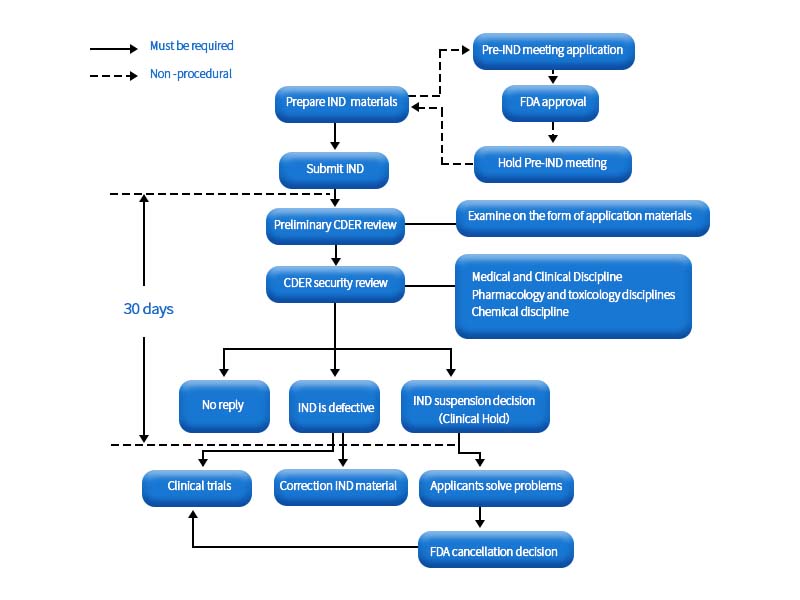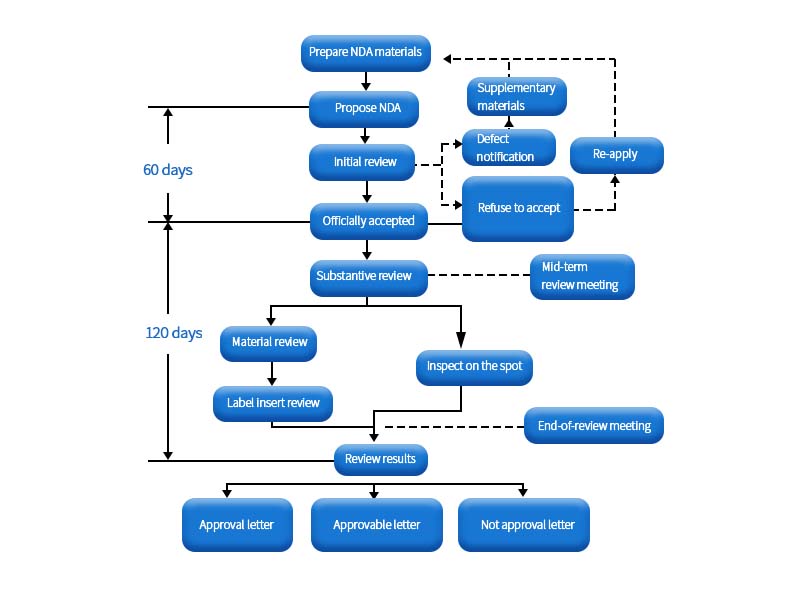Part1 Preclinical Research
1 Research And Development (Generally 2-3 Years)
Research in the laboratory to find new compounds with potential to treat specific diseases.
Discovery And Validation Of Drug Targets
This is the starting point of all work. Only when the target is determined, can all subsequent work be carried out.
Compound Screening And Synthesis
According to the spatial structure of the target, a series of matching molecular structures are screened from the virtual compound library, and these compounds are synthesized, which are called lead compounds.
Validation And Optimization Of Active Compounds
Not all lead compounds can meet the requirements. At this stage, it is necessary to pass in vitro cell test verification, initially screen out compounds with high activity and low toxicity, and optimize their structures based on the structure-activity relationship. These compounds are called drug candidates.
At the same time, there is also a situation where a compound has no effect on the target A target, but may have very good activity on other B targets and C targets, which will not be shown for the time being.
2 Preclinical Experiments (Generally 2-4 Years)
The purpose of this stage is to evaluate the pharmacological and toxicological effects of the drug, and the absorption, distribution, metabolism and excretion (ADME) of the drug. The second is to conduct research on production technology, quality control, and stability (CMC).
The first part of the experiment needs to be carried out at the animal level, and the results of cell experiments and the results of live animal experiments sometimes have great differences. The purpose of this step is to determine the effectiveness and safety of the drug.
The second part needs to be completed in a workshop that meets GMP requirements.
Pharmacological Research
Including: Pharmacodynamics, Pharmacokinetics
Toxicology Research
Acute toxicity, long-term toxicity, reproductive toxicity, carcinogenicity, teratogenicity, and mutagenicity
Formulation Development
You can’t just pour some compounds into your mouth. Preparation development is an important part of drug application. For example, some drugs are poorly absorbed orally, so they need to be developed as injections.
Some drugs will lose their activity in gastric acid, so they need to be developed into enteric-coated preparations.
Some compounds have poor solubility, which can also be partially solved by formulation.
Others need to be administered locally, so they need to be developed into nebulizers, ointments, etc. through formulations.
Part2 Clinical Trial Approval
Investigational New Drug (IND)

Part 3 Clinical Trial (Generally 3-7 Years)
There Are Three Phases Of Human Trials:
- Phase I clinical trials: 20-100 cases, normal people, mainly for safety evaluation.
- 100-300 patients in Phase II clinical trials, mainly for effectiveness evaluation.
- 300-5000 patients in phase III clinical trials, expand the sample size for further evaluation.
Because phase I-III clinical trials are very important in the entire drug development process, we will focus on this part.
Traditionally, the clinical research of new drugs is divided into phase I/II/III, and later phase II is divided into IIa and IIb (largely because of tumor drug research), followed by the concept of phase 0 research (largely Also because of cancer drug development). Then it was proposed that phase 0/I is early clinical research, IIa is mid-term clinical research, and phase IIb and III are late clinical research.
In fact, I think this classification is very important to those of us who design clinical research in two aspects:
- The staging is related to the purpose of the research. Different purposes can be divided into different periods/stages.
- Clinical research in different periods/stages often corresponds to a certain research framework design (crossover research, parallel control, single arm, endpoint selection, etc.).
Therefore, the significance of understanding clinical research in different periods/stages has gone beyond knowing that there is such a division itself.
One end of the staging is the research purpose, and the other end is the corresponding design framework (of course, it is only a rough framework, many problems should be determined according to diseases, drugs, etc.), understanding the staging will help us understand that a research purpose, in general What design methods and ideas are there, and how to deal with them in general; why it should be done in this way, and where are the advantages and disadvantages of various designs.
So, let’s take a look at the research objectives at different stages.
1.Phase 1.0
The purpose is to preliminarily judge whether a research drug is effective in a limited sample size (usually no more than 20) and within a limited time period (the treatment period of each patient is usually no more than a few weeks) under the premise of meeting certain statistical requirements , Whether a certain dose is effective, whether it should continue to be developed, and whether some methods of judging the efficacy are feasible.
From the perspective of purpose, phase 0 study is also to preliminarily judge the effect of the drug, similar to phase II (especially IIa), so the design of phase 0 is similar to the single-arm study of IIa in some respects, but due to the small sample size and certain requirements. Statistical requirements, so it also has its own characteristics, the design may actually be more complicated.
2.Phase I
Usually it is to explore the dose (dose finding, dose-ranging), pharmacokinetics (PK) and pharmacokinetics (PD), and the sample size is not large (generally no more than 20, or around 20). Especially for PD, crossover studies are often used because crossover studies have their own characteristics and are suitable for this type of design purpose.
In a crossover study, each patient is its own control (in different stages, they play the roles of the research group and the control group), and the variables of the crossover study are generally smaller than the parallel controls, so the efficiency of the crossover study is far greater in terms of sample utilization. Higher than the parallel control, if 20 patients are included in the cross-over study, similar results may not be obtained with 50 parallel controls.
However, cross-control also has many limitations. For example, drop-out and loss-of-follow-up have a much greater impact on cross-over studies than parallel controlled studies; the same person receives different treatments at different times, and the interval is a washout period, resulting in residual effects and treatment-time interactions. and many more. Therefore, in the late stage of clinical research and development, it is rare to see useful cross-controls (there are, but far less than parallel controls).
3.Phase II
Phase II is the preliminary judgment of efficacy and safety (in fact, safety runs through the research and development), so it is generally called safety & activity research (SA research). There are many approaches. According to different clinical disease environments and previous data, single-arm, parallel-controlled RCT can be used. Surrogate is generally selected as the endpoint instead of clinical outcome. If divided into IIa and IIb, IIa is often a single arm, and the sample size is generally not more than a hundred; IIb is often a parallel RCT.
4.Phase III
Phase III is a rigorous confirmatory clinical study for verifying drug effects. Many conferences introduce clinical research, often using such research as a template for presentations, and presenting them under the framework of hypothesis testing.
Part 4 New Drug Marketing Approval
New Drug Application
NDA application information — CTD (Common Technical Document)
CTD is mainly composed of five modules:
①Administrative and regulatory information
②Overview: a high-level summary of drug quality, non-clinical, and clinical trials ③Detailed description of drug quality
④Non-clinical research reports ⑤Clinical research reports
Process:

①Approval Letter
Meet the requirements and can be listed
②Approval letter
Basically meets the requirements, and a few deficiencies can be modified. The applicant should respond and correct within 10 days of receipt, otherwise it will be deemed to be withdrawn automatically.
③Rejection letter
There are serious problems or a large amount of information needs to be supplemented. The applicant may file an amendment within 10 days or request a hearing within 30 days
NDA Special Review Procedure
①Priority Reviews (Priority Reviews) are applicable to drugs that can significantly improve the treatment, diagnosis or prevention of diseases compared with marketed drugs, and NDA review is given priority.
② Accelerated Approval (Accelerated Approval) is for drugs used to treat serious or life-threatening diseases, and there is a reasonable and measurable “surrogate endpoint”, that is, an indicator of the expected therapeutic effect of the drug, flexible review criteria, using ” Surrogate Endpoints” review.
③ Fast track (Fast-track) For drugs used to treat serious or life-threatening diseases, and have the potential to meet unmet clinical medical needs, early intervention, close communication, and submission of application materials in stages.
Taking Vioxx as an example, Vioxx submitted an NDA application on November 23, 1998, No. 21-042, “It was approved by the FDA on May 20, 1999, which lasted 178 days.
Part5 Post-Market Research
Clinical monitoring period: Phase IV clinical
The number of subjects should be greater than 2000, and a social investigation should be conducted at the same time.
Still take Vioxx as an example: “VIGOR” gastrointestinal trial was conducted in 2000 – showed less gastrointestinal side effects, but caused 2 times the risk of heart attack/stroke after 18 months of use.
2001, “APPROVe” Adenomatous Polyposis Prevention Trial – Higher Risk of Cardiovascular Disease with Medication Over 18 Months.
Part 6 Re-approval After Listing (Generally 4-10 Years After Listing)
Purpose: Re-examine efficacy and safety in NDA.
Vioxx, April 2002: Merck adds Vioxx warning of possible cardiovascular side effects.
On September 28, 2004, Merck and the FDA discussed the results of the Vioxx trial.
On September 30, 2004, re-evaluation: “Viox”, voluntarily recalled by Merck.










